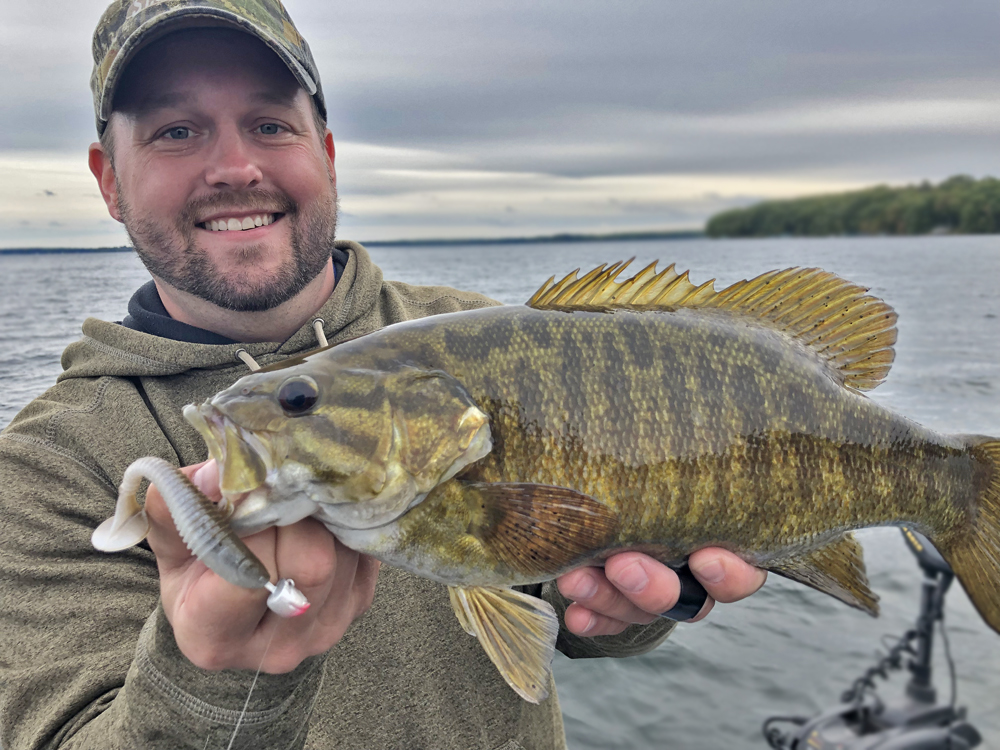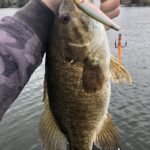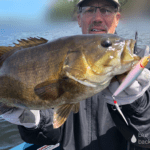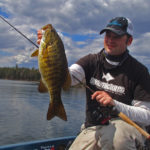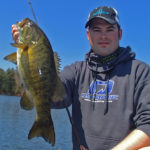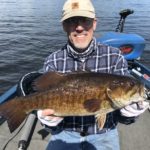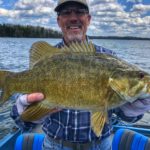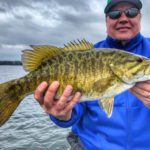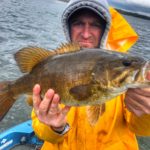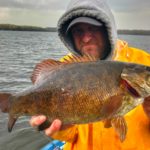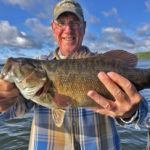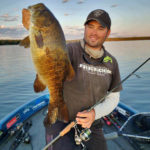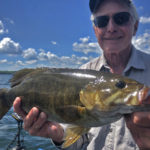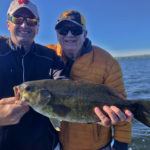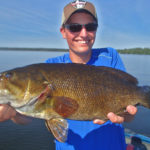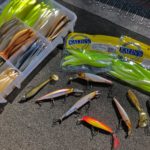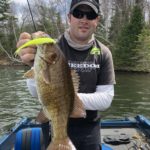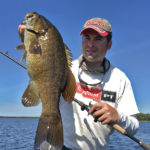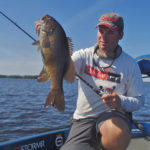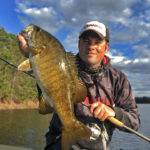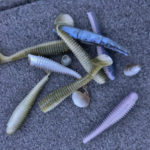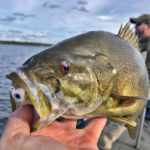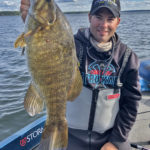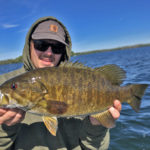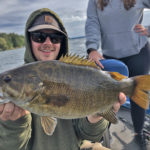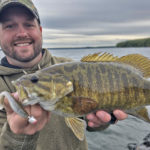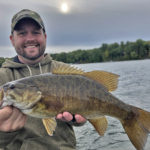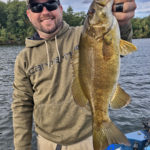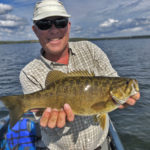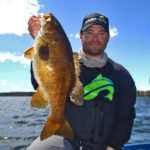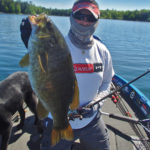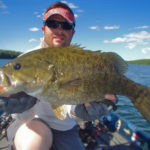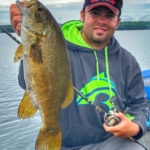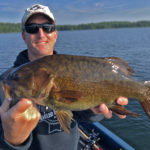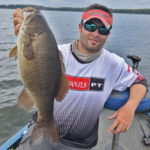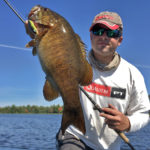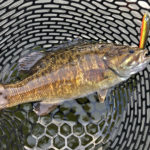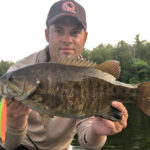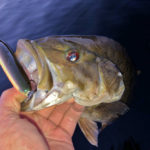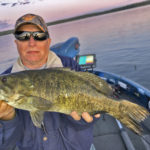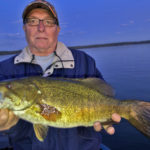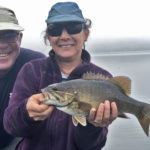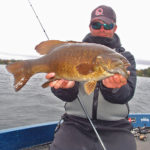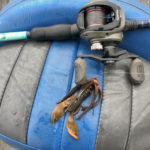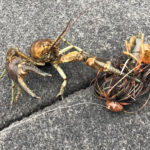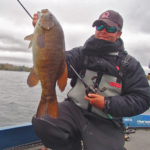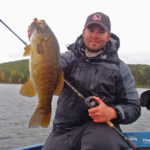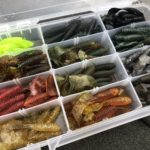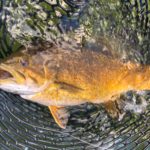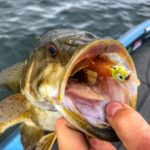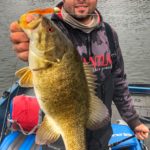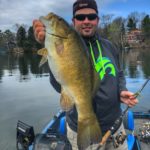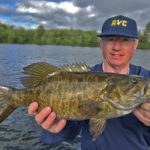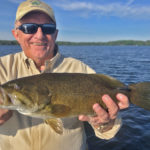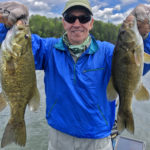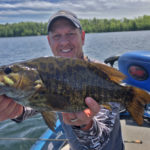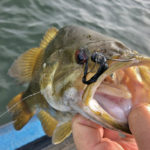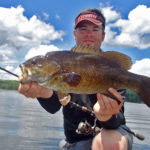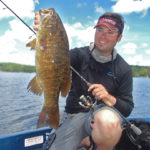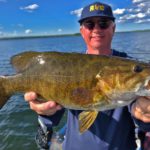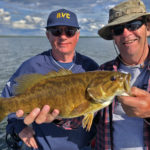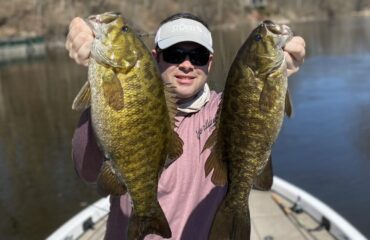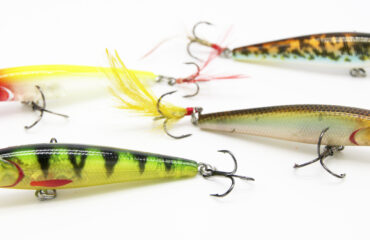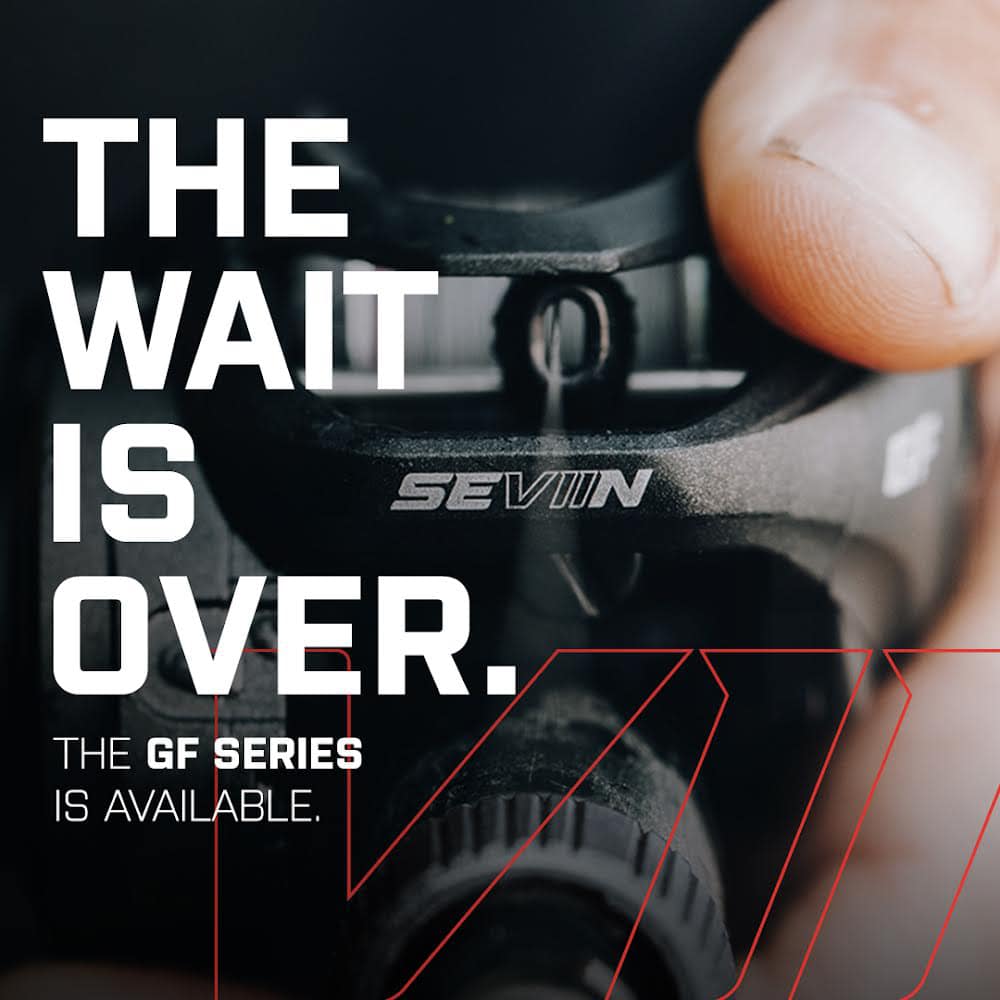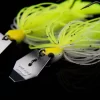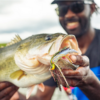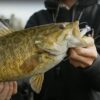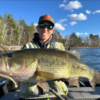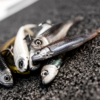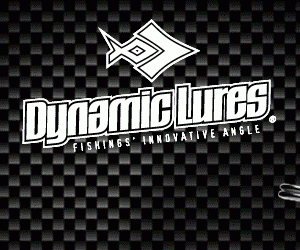Top Smallmouth Bass Baits of 2019
By Andrew Ragas
At the end of every season, I reveal the secret baits that caught the most fish for customers and I. Now that my 2019 bass fishing season has concluded, we glance back at the dominating baits and presentations that screamed success for big fish this year. Revisiting the old, consistent standbys from each of the previous years, and revealing some new.
I have to be on the top of my game daily, and my only requirement in all fishing lures is they better catch fish for my guests and I, providing we are skilled at using them and manipulating their every movement and action! At any given time, I keep up to 10 rods rigged and ready with an assortment of fish catchers at my Ranger’s front deck….. along with another 10 or so below in its rod locker. Overkill, yes. But here’s my logic: A diversified lure selection like this will help not only make you a more versatile bass angler, but allow you to catch more fish and be prepared for the called upon presentation at any given time.
Prime patterns and favorite lures can be revisited each year, especially as the environment and behaviors of smallmouth bass dictate their locations and influence their feeding habits. Each year a few annual constants remain, but new discoveries and techniques succeed in the underwater world below me.
As any observant and scientific-minded angler can conclude, the success you have with your favorite lures and technique-specific methods depends on weather and water conditions, fish locations, and habitats.
On the lakes and rivers you fished throughout 2019, what were some of your favorite and most productive methods to catch big fish throughout the year?
Here are this season’s winners, in no specific order. 2019 was the first season a tube jig wasn’t nominated.
[su_divider top=”no”]
Dynamic Lures Jspec Modified with Dressed Rear Treble Hook
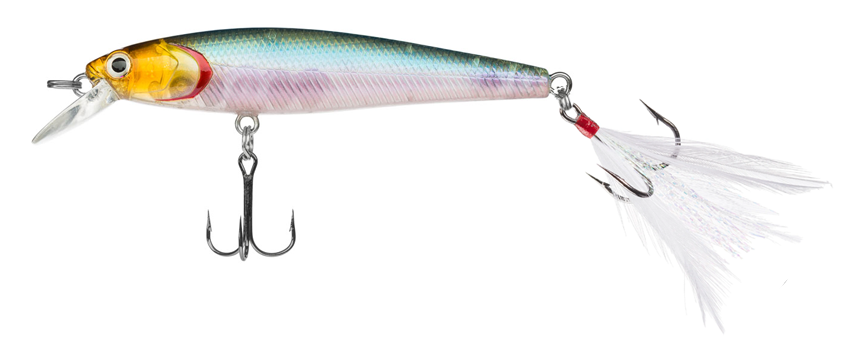
In 2019, customers and I made the Jspec more effective to smallmouth bass by attaching dressed treble hooks to the lure’s rear. The immediate results that followed were incredible. We turned a lively but dull looking bait into one that now has a lot more excitement.
You can buy dressed treble hooks from anywhere online, but we took an order of Trokar TK 300 trebles to a fellow who hand tied our own custom feathered hooks. We’ve complimented the Jspec with dressed trebles in a variety of colors and flashabou materials.
The Dynamic Lures J-Spec is the Ultimate 3 inch jerkbait. Retailing at $7.95, these unique suspending jerkbaits produce an erratic action that triggers aggressive bites. With great suspending action the J-Spec is a great choice to use when targeting smallmouth bass in the shallows, less than 10 feet. The J Spec suspending jerkbait rivals the best suspending hard baits on the market today. Nothing is worse than having trophy fish come unpinned from weak and dull treble hooks. For best results, replace factory hooks with Trokar Tk300 round bend treble hooks.
I fish suspending jerkbaits about 50% of the time and always have at least a few different types tied onto my rods year-round. My favorites are Ghost Fish, Holo Gold, and Chartreuse Shad. I typically work the J Spec on 7 foot medium heavy action spinning rods and reels with 8 lb monofilament and copolymer lines with sharp tugs. The internal weight system and style of polycarbonate lip allows the JSpec the suspend and crank deeper than other comparable lures. The aggressiveness of each jerk and the length of the pause between them varies largely by water temperature and by the stage of any weather front pushing through. Cool water temperatures and post-frontal conditions call for a very slow approach while actively feeding smallmouths and warm water situations demand aggressive jerk and pop techniques.
In 2019, especially during May pre-spawn, the J Spec accounted for several smallmouths up to 20 inches for my guests and I.
[su_divider top=”no”]
Rapala X-Rap sizes 08 and 10 – Hot Head
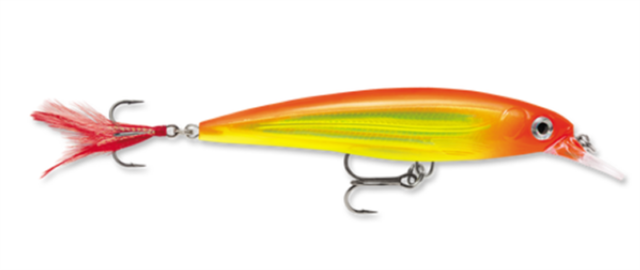
It’s timeless, simple, and slimmed down compared to other suspending jerks and slashbaits I throw. Often the best baits are those that remain unchanged, and continue to produce year after year.
The size 08 and 10 Hot Head X-rap was a go-to for customers and I throughout the spring and summer seasons when smallmouth were on a baitfish feed.
Size 08 is applicable on spinning gear, and fared best in low wind conditions, and also when fish had a smaller forage preference.
Size 10 meanwhile is often a big fish target. In May 2019, we had many cold and windy days in which the slower retrieve and bulkier profile of size 10 was in favor and the only bait smallmouth’s would slash at.
The Hot Head color is perfect for northwoods smallmouth. It contrasts best on my tanic brown waters, and can be seen by fish from miles away on the clearest waters. It’s the only color one ever needs.
Due to its slender profile and strong construction, the X-Rap is built for accurate, long distance casting. What separates this suspending jerk from others is I can fish the size 08 comfortably with my favorite 7ft med. heavy spinning rod with high-speed Quantum Smoke 30 Speed Freak reel. Meanwhile the size 10 can be fished with any 6ft 10″ medium heavy-fast, and 7 foot, casting rod spooled with 10 or 12 lb monofilament or fluorocarbon.
The X-Rap incorporates a long-cast design, enabling weights to shift during the cast. Its weight-forward design is a benefit because it allows anglers to cover vast amounts of water quickly, making it an effective search bait. The key characteristic of the X-Rap is that it can be fished in any type of manner and according to the moods and feeding patterns of the fish. This correlates with the retrieve of the X-Rap and the way it is fished as it involves a lot of mixing and matching according to the behavior of the fish.
My success with the X-Rap is always dictated by the activity and aggression levels of the fish. For instance, on days when smallmouths are active and striking everything in sight, I prefer retrieving the X-Rap with an erratic hard wrist twitching and rod ripping motion. In this situation the rod tip is pointed down towards the water and I employ a rapid erratic rip-pull-rip motion through the water. After a series of 3 to 5 rips, I allow the lure to pause for a second before resuming the motions again. Another tactic that works well is the sweep retrieve. This is similar to the hard twitching retrieve but instead of rapid erratic jerks I use longer, more powerful jerks with slightly longer pauses.
The X-Rap family of baits comes with a pair of razor-sharp VMC trebles, but I recommend swapping them in favor of Trokar Tk300 round bend treble hooks.
[su_divider top=”no”]
Modified Ned Rig
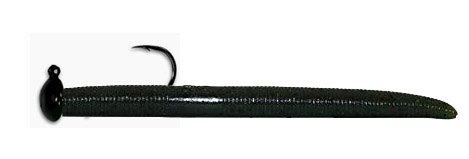
The Ned rig came onto the bass fishing scene a few years ago when Ned Kehde concocted this jig worm. Since then, the entire bass fishing world has gone mad and fallen in love with it. It excels in difficult fishing conditions, on pressured waters, and is one of the best finesse fishing options to consider.
2018 was my personal introduction to the Ned, and many eye-opening experiences followed. Since then, I’ve kept it tied onto a rod ever since and our results in 2019 were no different.
It’s a numbers presentation, but it’s one that targets some of the largest bass living in the most pressured lake systems. It’s also the bait to use when smallmouth don’t show interest in tubes or other jigging methods.
Traditionally a small profile, the Ned Rig is typically fished with a 1/16 to 1/8 oz. mushroom style jig head, and tipped with a 2 to 3 inch tail segment of a stick worm. The flat mushroom style jig head allows a stick bait to stand and be presented upright. This is an angle bass are new to.
Even though many anglers fishing the rig are scoring gargantuan numbers of bass and experiencing 50 to 100 fish days with it as a finesse option, the Ned Rig is my solution for big smallmouth when they’re fixated on leech patterns – typically from mid June through August.
Rather than use the most common Ned Rig sizes and styles, I have taken the approach to a different level and modifying it for my big bass. I fish it with a 5/16 oz. mushroom head. Then, rather than use a small piece of worm on the business end, I will rig an entire 5 inch full bodied stick. This weeds out all of the dinks. The modified AR ned is a trophy producing jig worm.
I bomb cast it for long distances, and hop and dead stick it along the bottom in order to imitate a leech. Always keep pressure on the line in order to detect the most subtle bites. An immediate hook set will result in the bass connecting with hook in the roof of the jaw, 99% of the time.
Black colors only. Any worm manufacturer is fine. As long as it’s solid black or smoke color to represent a leech. I have friends (Execution Lures) custom pour me stiffer worms so I can catch up to 10 fish per 1 bait. I also turn to Kalin’s Fishing Wacko Worms, and Bizz Baits, too.
Northern Wisconsin smallmouth bass are in trouble for seasons to come……… until they become conditioned and it’ll be time to reinvent the wheel.
[su_divider top=”no”]
Kalin’s Fishing Jerk Minnows
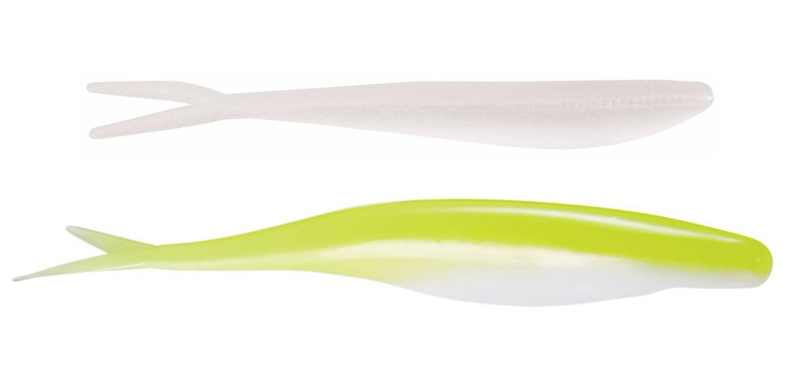
For most smallmouth fishing strategies we employ in spring, minnow imitating plastics and an array of suspending jerkbaits lead the way. Experiment with all shapes and sizes, colors, and lip profiles until you find a best match to your lake and its SMB residents. Soft plastics such as the Kalin’s Jerk Minnow in 5″ and Jr. 4″ sizes will get bit when hard baits aren’t getting lookers. Toss them weightless, on a jig, or on a Carolina rig.
Equally effective for smallmouths, and sometimes even better depending on fish activity levels, soft jerkbaits such as Jerk Minnows can be fished with the same cadence as a hard jerkbait to draw strikes. I fish them May through October and it catches fish during all months of my open water season. It draws strikes from aggressive fish, but also triggers reluctant strikes from wary and conditioned fish. Soft jerkbaits like this will produce when the hardbait won’t. It’s important to work a soft jerkbait just as you would a hard jerkbait. Rigged weightless with a 3/0 Eagle Claw Trokar MagWorm with plastic barb keeper, which keeps it honest and gives it a slow sink, I make sure to pop the bait with a few upwards jerks and let it hang and glide slowly down a few feet in the water column. Smallmouths often slurp it and strike aggressively on the pause, and slow flutter downward. When it’s their time to be used, soft jerkbaits offer a greater hang time in strike zones and will always sink at a slow minimal rate. Additionally, they will offer livelier finesse action which I believe is what tempts conditioned fish and big and old experienced bronzebacks to strike. The soft jerkbait will often catch smallmouths from the same spots where the hardbait blew past them moments earlier, and will generate new strikes on conditioned fish. When the tex-posed approach isn’t working, I will also vertically jig, or cast and rip jig the Jerk Minnow Jr with a Northland Slurp Jig.
Finding and catching smallmouths with hard and soft jerkbaits isn’t only a visual presentation for fish, but it’s also a visual experience for anglers. Because the majority of my bites occur on slack line while the hardbait is suspending or softbait is on the glide downward, I always keep my eyes fixated on the top six inches of my rod throughout the entire retrieve. Regardless of light penetration and weather, it’s important to keep a watch on your line and the rod tip. Always fish this with spinning gear, 7ft medium heavy action spinning rod with reel spooled with 8 or 10 lb. copolymer or fluorocarbon line. Trust me on the spinning gear, you will number up on so many smallies, beyond your wildest dreams.
[su_divider top=”no”]
A jig and paddletail remains a simple and effective fish-finder for me. I’m sure it will play well on your favorite clear water smallmouth fisheries too. Take a paddletail, and rig it on a favorite swimming style jig head. Easy and engaging fishing!
It’s the perfect strategy for covering water on windy days, bomb-casting the open water amid cisco schools, and targeting big fish.
We fish with three jig and paddletail combinations.
Strike King Rage Swimmer with Trokar Boxing Glove Jig
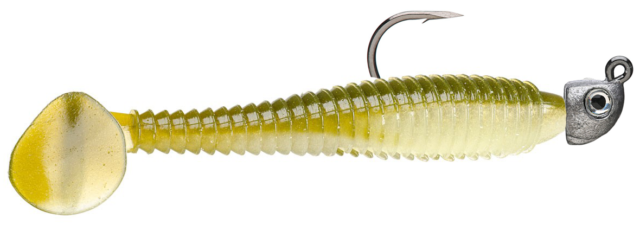
From late spring post-spawn, through early fall prior to turnover, Strike King Rage Swimmers on a 1/4 or 1/2 oz. Trokar Boxing Glove Jig accounted for several big smallies, explosive strikes, and major numbers of them from many clear water lakes. It caught fish year-round.
Bomb cast and let the wagging tail and wobble of the head do the work for you. A slow, steady retrieve is best, but I will mix it up with periodic pauses so that the bait slow-rolls back to the bottom. The key is to keep the bait swimming slowly just above the structure and the depths bass are at. A medium, steady retrieve is best with med. heavy action spinning setup, or medium action casting setup.
The rage swimmer features a fat body section, and thin tail that produces a slow wag that’s deadly on A-Rigs and jig set-ups. If you see a lot of 3- and 4-inch cisco or yellow perch swimming around, or bass blowing up on bluegills and other baitfish in the shallows, that’s my identifier to fish a paddletail. Another situation would be if you see smallmouths suspended over structure or corralling schools of perch or ciscoes. Keep in mind that in our clear water, smallmouths are sight feeders, so matching the hatch is of utmost importance. Ayu and Crystal are the only Rage Swimmer colors I use.
My bait combo is fished exclusively with the Trokar exposed hook jighead. It pins every fish that strikes. Great for covering water, catching aggressive smallmouths, and huge ones.
3.8″ Kalin’s Sizmic Shad with Trokar Boxing Glove Jig

Way more durable than the above Strike King, the Kalin’s Fishing Sizmic Shad is built from more durable plastic on the body segment that holds up to multiple fish before having to retire them.
In 2019, Kalin’s modified the formerly stiff paddletail with a more flexible and livelier plastic formula. Once requiring a very heavy jig for best action, the new and improved Sizmic Shad doesn’t require much weight anymore to be fished successfully.
We fish this durable swimmer with a combination of 3/8 oz. and 1/2 oz. Trokar Boxing Glove Jigs and Northland Slurp! Jigs. During the hot swimbait bite of September 2019, it accounted for several feeding frenzy smallmouths that were schooling up on shallow sand and grass flats to chase schools of yellow perch.
5″ Big Bite Baits Suicide Shad with 1/2 oz. Trokar Boxing Glove Jig

Fish bigger baits for bigger fish. That’s the best way to describe the 5-inch Big Bite Baits Suicide Shad when paired with a 1/2 oz. Trokar Boxing Glove Jig. When big smallmouth are favoring a slightly larger profile in spring and summer, this combo is unbeatable.
The suicide shad was the best big fish producer on cisco fisheries in 2019. The larger profile of the suicide shad in AYU and HERRING pattern is one of the best representations of the most common size of ciscoes.
Lifelike with lively tail and available in many translucent colors. It’s also durable to withstand multiple bites while being hooked to the collar of a swimbait jig. Even when the nose gets worn and ripped off, cut down the bait and continue using it. It will still produce just as well as a 4.5″ model, and downsized 4″ model. This is the bait’s best attribute.
[su_divider top=”no”]
Rapala Skitter V

Topwaters and surface baits, longtime bass fishing staples at night, are popular for smallmouths. They are hard to beat when surface activity is prevalent, the lakes are heating up from the sunlight above, and insect hatches take place. When either of these conditions are in play, topwaters often get eaten quickly, and generate vicious strikes.
New for 2019, the Rapala Skitter V in hot olive pattern has become one of my favorite walk the dog style surface baits. It pushes a substantial amount of water, and it’s V cut underside prevents the bait from rolling over sideways.
Long casts on 20 lb. Cortland Masterbraid and 3 ft section of 16 lb. mono leader, with powerful sweeps of the 7ft 2″ med. hvy fast action baitcasting rod to generate the optimal walk-the-dog retrieve cadence, and mix some pauses and breaks in between. Trust me, you will want the mono leader; it keeps baits floating, and provides necessary stretch for successful hook sets so that you won’t rip the bait out from fishes mouths. The big strikes and huge fish surface lures produce from shallow water during July and August months will make you wonder whether you’re fishing the Amazon for peacock bass rather than the northwoods for smallmouth bass.
For this presentation, the shallow tops of bars will now become the focal point of your fishing. Rock bars, humps, and shoals are some of the best locations I’ve found for sunset and after dark fishing with topwaters. The tops of them all will usually have the sexiest elements of the structure which could be the largest rock or boulders. Smallmouth often gravitate to them in low light to use as an ambush point. They will also hold on these locations throughout the night, using them as resting areas for the night too.
Jewel Baits Pee-Wee Football Jig with craw Trailer
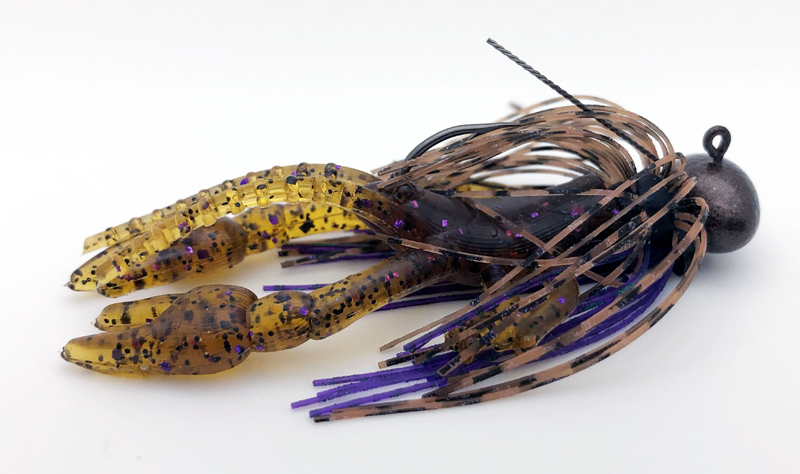
I stumbled onto this fish catcher during August 2019 while perusing some smallmouth bass fishing pages on Facebook. I have zero affiliation or agenda with any jig manufacturer currently, and therefore have been looking for and experimenting with the next great ones. I am glad I checked out a new product that I found works so well on our crayfish infested northwoods lakes.
The Jewel Pee-Wee Football Jig is a tremendous downsized finesse football jig that produces big bites from shallow and mid-depth rock structure. It comes in 3 sizes (3/16, 5/16, 7/16) that are heavy enough to sink quickly to the depths when fished with spinning gear.
It features a durable skirt that doesn’t rip off, a pivoted football head design, and a wire weed-guard that maintains its weedless characteristics but also doesn’t hinder its hook-up ratio. The flexible wire brush guard allows the jig to be fished in the worst and most dangerous bottom substrates, and allows for the lightest bites and pick-ups to be detected. In two months of fishing them almost daily, we only lost 1 jig to snags the entire time.
This fall season, we fished the Pee-wees with medium heavy action spinning gear; 7ft rods and size 20 Quantum Energy PT reels spooled with 15 lb. Cortland Masterbraid. Each trip we caught fish with it, we had them paired up with craw trailers such as the Bizz Baits Baby BizzBug. We feel this bait will be in the summer and fall arsenal for a long time. Our best colors were PBJ and Touchdown.
[su_divider top=”no”]
3/4 oz. Football Jig with Bizz Baits Killer Craw

Pardon my crude attempt at splicing jig and trailer together. I failed at this graphic design course, one which I can normally pass well. A heavy 3/4 oz. football jig paired with a Bizz Baits Killer Craw was one of the best baits of the fall 2019 season.
Don’t be afraid to throw football heads heavier than 3/4 oz. and match with a supersize craw trailer. Bizz Baits catches fish, while many other soft plastic brands and their color charts mainly catch only the angler. A natural color is available to match any species of crayfish. Bizz baits is the business end of my jigs! If you are a fall season smallmouth bass angler, stock up on these craw trailers and fish them with heavy jigs like this.
Rusty crayfish patterns rule on a number of northwoods trophy lakes. A heavy 3/4 oz. Gregg Kizewski football jig in camo craw paired up with a Bizz Baits craw will catch big smallmouth. Bomb cast and crawl it up the slopes and drag thru the shallow flats. If a fish is there, it’ll get smoked. For shallower depths, I downsize the same bait to a 3/8 oz model.
[su_divider top=”no”]
Kalin’s 5″ Lunker Grub with Northland Tackle Slurp! Jig
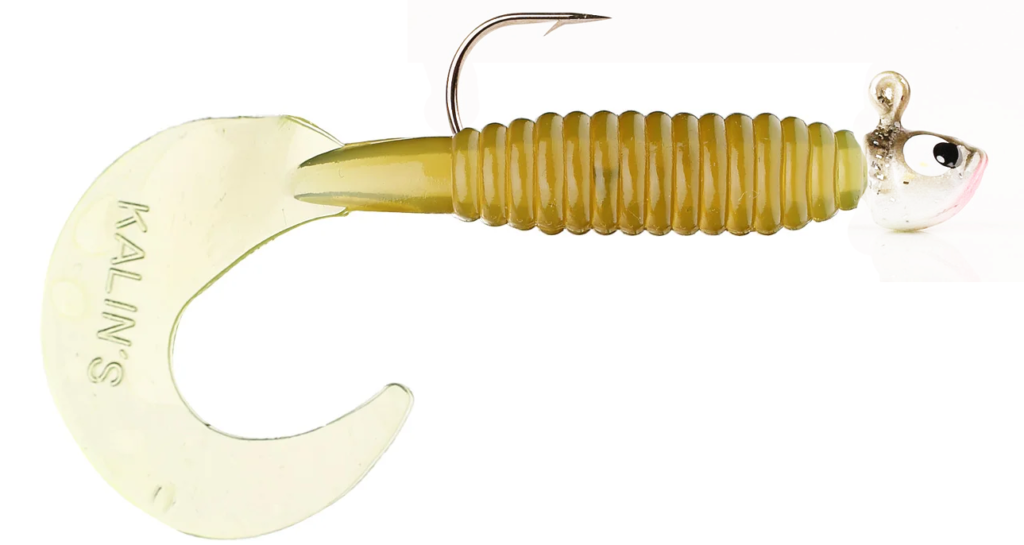
This May and June, the only baits I’ve really needed for anywhere was my box of Kalin’s Fishing 5” lunker grubs. They’re my fish finders and fish catchers on most smallmouth waters. You see the colors I have in the image below; I also have a lot of colors from 5-10 yrs ago that aren’t even made now.
When fishing cold water like we did this spring (middle to upper 40’s), slow rolling a heavy swimming grub will produce when not much else will. You can often get a nice flurry of bites along the first breaks in 10-15ft depth. A 5” Lunker Grub rigged with a 1/4 oz. Northland Tackle Slurp Jig will get the smallmouth to slurp.
Bomb cast along the breaks, and run your swimmer thru the lower water column. Turning your reel 1x every second will maintain it at these depths where fish are gingerly migrating up from the deep along these contours.
Another tip I want to share is about learning to fish new, unfamiliar waters. These same baits have always been my search lures and fish finders when exploring and learning new lakes. You can cover lots of water with them. Growing up, I learned to fish many lakes with aid of a Kalin’s grub. Simple and deadly fishing. If you river fish, no problem either. The swimming grub / twister tail soft plastic is tailor made for flowing waters and river environments.
I rig on an assortment of jigs depending on how and where I’m fishing. Ned heads and football heads for bottom dragging. Owner ultra heads for all purpose scenarios. Northland Slurp minnow heads, and Trokar boxing glove jigs for slow swimming and hitting smbs all throughout the water column.
The 5″ Lunker Grub is one of the best early season fish catchers, and is a must have for every smallmouth angler.
[su_divider top=”no”]
Hand-Tied Marabou Jigs
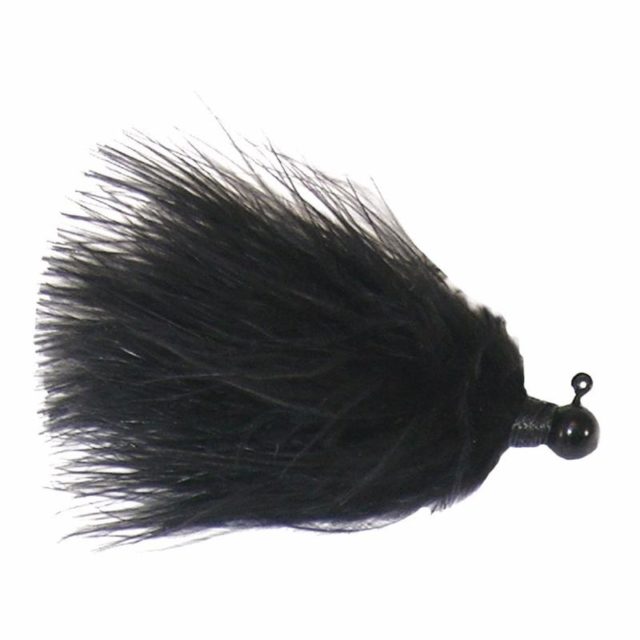
The breathing, living, pulsating action of the marabou jig has always made it popular for bass fishing. It’s one of the oldest jigging lures out there, made popular during the 1950’s and 60’s, then reborn and made popular again in modern times by notable Canadian bass tournament anglers. The success of hair jigs on Canadian and Great Lakes smallmouth fisheries has translated into success on my inland waters of WI.
While popular during bass fishing’s formative years, the hair jig is an unknown to today’s generation of smallmouth in our lakes.
I’d rather fish with other tactics, but what’s an angler to do when combating mayfly hatches, bug hatches, high skies and no wind, surfacing fish that won’t touch a topwater, and excessive angling pressure? Year-round, the hair jig outfishes anything else by a wide margin, and does so effectively in these adverse conditions. 2018 was the second straight year the hair jig caught loads of fish during the June and July post-spawn and early summer fishing periods.
The hair jig is something different, and not a lot of people have confidence using it yet. The ultra light-weight and extreme slow fall of the hair jig makes it possible to drag the bait across rough hard bottom terrain. The slow glide also enables it to hang in range of a smallmouth’s strike zone.
The main sizes most commonly used for this technique include 1/32 oz. 1/16 oz. and 1/8 oz. sizes. Wind, depth, line size, and how fast you plan to work the bait should all be considered when choosing the bait size that will work best on any given day. With medium light to medium extra fast action spinning tackle, I fish the lightest presentation that I can can get away with, on light 10 lb braid, or straight 6lb. fluorocarbon. The slow fall of these baits enables an angler to fish the bait horizontally through the water column at a very slow pace. Cast out as far as you can reach, let the jig glide down to the desired depth, point the rod tip down, and start reeling. Let the hair pulsate and do all the work for you. Lift and drop your rod throughout the retrieve also to trigger strikes.
Hair jigs will represent whatever you want them to be. Mayflies, leeches, crayfish, minnows, other invertebrates creatures and critters. Common colors are blacks, olives, browns, yellows, purples, maroons, tans, and greys.
End of June through early July has been an awesome hair jig bite. On some days, it’s been the secret weapon. When all else fails, the hair jig goes.
S/O to my friend and fellow bass guide, Gregg Kizewski, for tying up some of the best hair products for bass. Best of all, besides quality – they’re made locally.
Lots of hair jig brands and jig tiers are out there. Crafty jigs abound. You can adjust their rate of fall experimenting with different sizes of braid and fluorocarbon lines. When the going gets tough, get going for smallmouths on hair jigs.
If you’ve located the fish, try these smallmouth bass baits and tactics for next year. These all highlighted my season of excellent catches. A diversified lure selection will not only make you a more versatile angler, but allow you to catch more fish. Prime patterns and favorite lures can be revisited each year, especially as the environment and behaviors of smallmouth bass dictate their locations and influence their feeding habits.
Chasing trophy smallmouth bass year round requires a good lure selection of fish catchers like this. Be diverse, and not one-dimensional.
What were your best of 2019? Feel free to comment in the space below!


